Underwater Cultural Heritage Documentation Using Photogrammetry
Abstract
:1. Introduction
2. Underwater Photogrammetry
2.1. Preliminary Consideration in Underwater Photogrammetric Data Acquisition and Processing
2.1.1. Acquisition Depth and Time Restrictions
2.1.2. Photogrammetric Acquisition Methods
2.1.3. Reconstruction Accuracy
2.1.4. Processing Algorithms
2.2. Optical and Physics Issues Related to Underwater Photogrammetry
2.2.1. The Underwater Spectrum of Light and Selective Absorption
2.2.2. Diffusion and Backscattering
2.2.3. Reflection and Refraction of Light in Water
2.2.4. Refraction in UW Photogrammetry: Flat and Dome Ports
2.3. Optical and Physics Issues Related to Underwater Photogrammetry
2.3.1. Geometric Aspects of Underwater Imaging and Stereo Reconstruction
- Camera motion: Any camera movement, underwater or on the surface, can cause blur and noise in images. This is particularly important for underwater photogrammetry, as the water can make it difficult to keep the camera steady.
- Waves and currents: Waves and currents can cause underwater objects to move, leading to blurring in underwater photographs. This can also make it difficult to stitch together multiple photographs to create a complete 3D model.
- Reflections: Underwater surfaces can reflect light, creating distracting photograph artifacts. These reflections can also make identifying features in the image data difficult (Figure 10).
- Calibration: The accurate calibration of underwater imaging systems is essential to account for geometric distortions and ensure the correct alignment of images or signals from multiple sensors [38].
- Dewarping: Dewarping algorithms can correct refraction and other geometric distortions in underwater images or signals [39].
- Noise reduction: Various noise reduction techniques, such as filtering and averaging, can be applied to reduce the impact of electronic and environmental noise on underwater data [40].
- Stereo reconstruction: Stereo reconstruction algorithms can fuse images or signals from multiple underwater sensors to reconstruct a 3D model of the scene [41].
2.3.2. Camera Calibration
- f—the focal length.
- cx and cy—the principal point coordinates, i.e., lens optical axis intersection coordinates with sensor plane.
- b1 and b2—the affinity and non-orthogonality (skew) coefficients.
- k1, k2, k3, and k4—the radial distortion coefficients.
- p1 and p2—the tangential distortion coefficients.
2.4. Radiometric Correction of Images
3. The Use of Drones in Underwater Photogrammetry
3.1. UAS Photogrammetry in Very Shallow Water
3.2. Remotely Operated Vehicles (ROVs) in Underwater Photogrammetry
- Enhanced safety: ROVs eliminate the risks associated with human divers, such as decompression sickness, entanglement, and hazardous marine life encounters.
- Deeper reach: ROVs can operate at depths beyond the reach of human divers, providing access to a wider range of underwater environments.
- Increased flexibility: ROVs can navigate complex underwater structures and environments with greater maneuverability than towed cameras.
- Automated data acquisition: ROVs can be programmed to follow predetermined paths and capture images autonomously, reducing operator fatigue and increasing efficiency.
4. Discussions
5. Conclusions
Author Contributions
Funding
Institutional Review Board Statement
Informed Consent Statement
Data Availability Statement
Conflicts of Interest
| 1 | https://github.com/deborahLevy130/seathru_NeRF (accessed on 1 February 2024) |
| 2 | https://github.com/warplab/DeepSeeColor (accessed on 1 February 2024) |
References
- Rissolo, D.; Blank, A.N.; Petrovic, V.; Arce, R.C.; Jaskolski, C.; Erreguerena, P.L.; Chatters, J.C. Novel Application of 3D Documentation Techniques at a Submerged Late Pleistocene Cave Site in Quintana Roo, Mexico. In Proceedings of the 2015 Digital Heritage, Granada, Spain, 28 September–2 October 2015; Institute of Electrical and Electronics Engineers (IEEE): Piscataway, NJ, USA, 2016; pp. 181–182. [Google Scholar]
- Menna, F.; Agrafiotis, P.; Georgopoulos, A. State of the Art and Applications in Archaeological Underwater 3D Recording and Mapping. J. Cult. Herit. 2018, 33, 231–248. [Google Scholar] [CrossRef]
- Violante, C. A Geophysical Approach to the Fruition and Protection of Underwater Cultural Landscapes. Examples from the Bay of Napoli, Southern Italy. In La Baia di Napoli. Strategie per la Conservazione e la Fruizione del Paesaggio Culturale; Editori Paparo: Napoli, Italy, 2023; pp. 66–73. [Google Scholar]
- Ricca, M.; Alexandrakis, G.; Bonazza, A.; Bruno, F.; Davidde Petriaggi, B.; Elkin, D.; Lagudi, A.; Nicolas, S.; Novák, M.; Papatheodorou, G.; et al. A Sustainable Approach for the Management and Valorization of Underwater Cultural Heritage: New Perspectives from the TECTONIC Project. Sustainability 2020, 12, 5000. [Google Scholar] [CrossRef]
- Ricci, R.; Francucci, M.; De Dominicis, L.; Ferri de Collibus, M.; Fornetti, G.; Guarneri, M.; Nuvoli, M.; Paglia, E.; Bartolini, L. Techniques for Effective Optical Noise Rejection in Amplitude-Modulated Laser Optical Radars for Underwater Three-Dimensional Imaging. EURASIP J. Appl. Signal Process. 2010, 2010, 958360. [Google Scholar] [CrossRef]
- Bartolini, L.; De Dominicis, L.; de Collibus, M.F.; Fornetti, G.; Guarneri, M.; Paglia, E.; Poggi, C.; Ricci, R. Underwater Three-Dimensional Imaging with an Amplitude-Modulated Laser Radar at a 405 Nm Wavelength. Appl. Opt. 2005, 44, 7130–7135. [Google Scholar] [CrossRef] [PubMed]
- Skarlatos, D.; Agrafiotis, P.; Balogh, T.; Bruno, F.; Castro, F.; Petriaggi, B.D.; Demesticha, S.; Doulamis, A.; Drap, P.; Georgopoulos, A.; et al. Project iMARECULTURE: Advanced VR, iMmersive Serious Games and Augmented REality as Tools to Raise Awareness and Access to European Underwater CULTURal heritagE. In Digital Heritage. Progress in Cultural Heritage: Documentation, Preservation, and Protection; Ioannides, M., Fink, E., Moropoulou, A., Hagedorn-Saupe, M., Fresa, A., Liestøl, G., Rajcic, V., Grussenmeyer, P., Eds.; Lecture Notes in Computer Science; Springer International Publishing: Cham, Switzerland, 2016; Volume 10058, pp. 805–813. ISBN 978-3-319-48495-2. [Google Scholar]
- Opdebeeck, J. Shipwrecks and Amphorae: Their Relationship with Trading Routes and the Roman Economy in the Mediterranean; University of Southampton: Southampton, UK, 2005. [Google Scholar]
- Auriemma, R.; Quiri, E. Importazioni Di Anfore Orientali Nell’Adriatico Tra Primo e Medio Impero. In Transport Amphorae and Trade in the Western Mediterranean; J. Eiring e J. Lund: Athens, Greece, 2004. [Google Scholar]
- Marín-Buzón, C.; Pérez-Romero, A.; López-Castro, J.L.; Ben Jerbania, I.; Manzano-Agugliaro, F. Photogrammetry as a New Scientific Tool in Archaeology: Worldwide Research Trends. Sustainability 2021, 13, 5319. [Google Scholar] [CrossRef]
- McAllister, M. The Problem with “digital Realism” in Underwater Archaeology: Photogrammetric Digital 3D Visualization and Interpretation. J. Marit. Archaeol. 2021, 16, 253–275. [Google Scholar] [CrossRef]
- Skarlatos, D.; Agrafiotis, P. Image-Based Underwater 3D Reconstruction for Cultural Heritage: From Image Collection to 3D. Critical Steps and Considerations. In Visual Computing for Cultural Heritage; Springer: Cham, Switzerland, 2020; pp. 141–158. [Google Scholar]
- Abate, N.; Ronchi, D.; Vitale, V.; Masini, N.; Angelini, A.; Giuri, F.; Minervino Amodio, A.; Gennaro, A.M.; Ferdani, D. Integrated Close Range Remote Sensing Techniques for Detecting, Documenting, and Interpreting Lost Medieval Settlements under Canopy: The Case of Altanum (RC, Italy). Land 2023, 12, 310. [Google Scholar] [CrossRef]
- Ceccarelli, S.; Guarneri, M.; Ferri de Collibus, M.; Francucci, M.; Ciaffi, M.; Danielis, A. Laser Scanners for High-Quality 3D and IR Imaging in Cultural Heritage Monitoring and Documentation. J. Imaging 2018, 4, 130. [Google Scholar] [CrossRef]
- Di Stefano, F.; Torresani, A.; Farella, E.M.; Pierdicca, R.; Menna, F.; Remondino, F. 3D Surveying of Underground Built Heritage: Opportunities and Challenges of Mobile Technologies. Sustainability 2021, 13, 13289. [Google Scholar] [CrossRef]
- Pulido Mantas, T.; Roveta, C.; Calcinai, B.; di Camillo, C.G.; Gambardella, C.; Gregorin, C.; Coppari, M.; Marrocco, T.; Puce, S.; Riccardi, A.; et al. Photogrammetry, from the Land to the Sea and Beyond: A Unifying Approach to Study Terrestrial and Marine Environments. J. Mar. Sci. Eng. 2023, 11, 759. [Google Scholar] [CrossRef]
- Calantropio, A.; Chiabrando, F.; Seymour, B.; Kovacs, E.; Lo, E.; Rissolo, D. Image Pre-Processing Strategies for Enhancing Photogrammetric 3d Reconstruction of Underwater Shipwreck Datasets. ISPRS—Int. Arch. Photogramm. Remote Sens. Spat. Inf. Sci. 2020, 43B2, 941–948. [Google Scholar] [CrossRef]
- Doležal, M.; Vlachos, M.; Secci, M.; Demesticha, S.; Skarlatos, D.; Liarokapis, F. Understanding Underwater Photogrammetry For Maritime Archaeology through Immersive Virtual Reality. Int. Arch. Photogramm. Remote Sens. Spatial Inf. Sci. 2019, XLII-2-W10, 85–91. [Google Scholar] [CrossRef]
- Akkaynak, D.; Treibitz, T. Sea-Thru: A Method for Removing Water from Underwater Images. In Proceedings of the 2019 IEEE/CVF Conference on Computer Vision and Pattern Recognition (CVPR), Long Beach, CA, USA, 15–20 June 2019; pp. 1682–1691. [Google Scholar]
- Balletti, C.; Beltrame, C.; Costa, E.; Guerra, F.; Vernier, P. Underwater photogrammetry and 3d reconstruction of marble cargos shipwreck. Int. Arch. Photogramm. Remote Sens. Spat. Inf. Sci. 2015, XL-5/W5, 7–13. [Google Scholar] [CrossRef]
- Costa, E. Survey and Photogrammetry in Underwater Archaeological Contexts at Low Visibility in the Venice Lagoon. Digit. Appl. Archaeol. Cult. Herit. 2022, 24, e00215. [Google Scholar] [CrossRef]
- Sapirstein, P.; Murray, S. Establishing Best Practices for Photogrammetric Recording during Archaeological Fieldwork. J. Field Archaeol. 2017, 42, 337–350. [Google Scholar] [CrossRef]
- McCarthy, J.; Benjamin, J. Multi-Image Photogrammetry for Underwater Archaeological Site Recording: An Accessible, Diver-Based Approach. J. Marit. Archaeol. 2014, 9, 95–114. [Google Scholar] [CrossRef]
- Livanos, G.; Zervakis, M.; Chalkiadakis, V.; Moirogiorgou, K.; Giakos, G.; Papandroulakis, N. Intelligent Navigation and Control of a Prototype Autonomous Underwater Vehicle for Automated Inspection of Aquaculture Net Pen Cages. In Proceedings of the 2018 IEEE International Conference on Imaging Systems and Techniques (IST), Krakow, Poland, 16–18 October 2018; pp. 1–6. [Google Scholar]
- Hu, K.; Wang, T.; Shen, C.; Weng, C.; Zhou, F.; Xia, M.; Weng, L. Overview of Underwater 3D Reconstruction Technology Based on Optical Images. J. Mar. Sci. Eng. 2023, 11, 949. [Google Scholar] [CrossRef]
- Jaffe, J.S. Computer Modeling and the Design of Optimal Underwater Imaging Systems. IEEE J. Ocean. Eng. 1990, 15, 101–111. [Google Scholar] [CrossRef]
- Bryson, M.; Johnson-Roberson, M.; Pizarro, O.; Williams, S.B. True Color Correction of Autonomous Underwater Vehicle Imagery. J. Field Robot. 2016, 33, 853–874. [Google Scholar] [CrossRef]
- Van Damme, T. Computer vision photogrammetry for underwater archaeological site recording in a low-visibility environment. Int. Arch. Photogramm. Remote Sens. Spat. Inf. Sci. 2015, XL-5-W5, 231–238. [Google Scholar] [CrossRef]
- Lide, D. Handbook of Chemistry and Physics, 86th ed.; CRC: Boca Raton, FL, USA, 2005. [Google Scholar]
- Borri, E.M. Fotografia Subacquea per Turisti Digitali; Edizioni FAG Srl: Assago, Italy, 2005; ISBN 978-88-8233-433-8. [Google Scholar]
- Menna, F.; Nocerino, E.; Remondino, F. Flat Versus Hemispherical Dome Ports in Underwater Photogrammetry. ISPRS—Int. Arch. Photogramm. Remote Sens. Spat. Inf. Sci. 2017, 42W3, 481–487. [Google Scholar] [CrossRef]
- Bruno, F.; Bianco, G.; Muzzupappa, M.; Barone, S.; Razionale, A.V. Experimentation of Structured Light and Stereo Vision for Underwater 3D Reconstruction. ISPRS J. Photogramm. Remote Sens. 2011, 66, 508–518. [Google Scholar] [CrossRef]
- Telem, G.; Filin, S. Photogrammetric Modeling of Underwater Environments. ISPRS J. Photogramm. Remote Sens. 2010, 65, 433–444. [Google Scholar] [CrossRef]
- Karpouzli, E.; Malthus, T.; Place, C.; Chui, A.M.; Garcia, M.I.; Mair, J. Underwater Light Characterisation for Correction of Remotely Sensed Images. Int. J. Remote Sens. 2003, 24, 2683–2702. [Google Scholar] [CrossRef]
- Cheng, H.; Chu, J.; Zhang, R.; Tian, L.; Gui, X. Turbid Underwater Polarization Patterns Considering Multiple Mie Scattering of Suspended Particles. Photogramm. Eng. Remote Sens. 2020, 86, 737–743. [Google Scholar] [CrossRef]
- Agrafiotis, P.; Skarlatos, D.; Forbes, T.; Poullis, C.; Skamantzari, M.; Georgopoulos, A. Underwater photogrammetry in very shallow waters: Main challenges and caustics effect removal. Int. Arch. Photogramm. Remote Sens. Spat. Inf. Sci. 2018, XLII–2, 15–22. [Google Scholar] [CrossRef]
- Menna, F.; Nocerino, E.; Remondino, F. Optical Aberrations in Underwater Photogrammetry with Flat and Hemispherical Dome Ports. In Proceedings of the Videometrics, Range Imaging, and Applications XIV, Munich, Germany, 25–29 June 2017; SPIE: St Bellingham, WA, USA, 2017; Volume 10332, pp. 28–41. [Google Scholar]
- Lavest, J.M.; Rives, G.; Lapresté, J.T. Underwater Camera Calibration. In Computer Vision—ECCV 2000; Vernon, D., Ed.; Springer: Berlin/Heidelberg, Germany, 2000; pp. 654–668. [Google Scholar]
- Simple Algorithm for Correction of Geometrically Warped Underwater Images—Halder—2014—Electronics Letters—Wiley Online Library. Available online: https://ietresearch.onlinelibrary.wiley.com/doi/full/10.1049/el.2014.3142 (accessed on 22 December 2023).
- Jian, M.; Liu, X.; Luo, H.; Lu, X.; Yu, H.; Dong, J. Underwater Image Processing and Analysis: A Review. Signal Process. Image Commun. 2021, 91, 116088. [Google Scholar] [CrossRef]
- Queiroz-Neto, J.P.; Carceroni, R.; Barros, W.; Campos, M. Underwater Stereo. In Proceedings of the Proceeding. 17th Brazilian Symposium on Computer Graphics and Image Processing, Curitiba, Brazil, 20 October 2004; pp. 170–177. [Google Scholar]
- Remondino, F.; Fraser, C. Digital Camera Calibration Methods: Considerations and Comparisons. Int. Arch. Photogramm. Remote Sens. Spat. Inf. Sci. 2006, XXXVI, 266–272. [Google Scholar] [CrossRef]
- Fraser, C.S. Digital Camera Self-Calibration. ISPRS J. Photogramm. Remote Sens. 1997, 52, 149–159. [Google Scholar] [CrossRef]
- Gruen, A.; Beyer, H.A. System Calibration Through Self-Calibration. In Calibration and Orientation of Cameras in Computer Vision; Gruen, A., Huang, T.S., Eds.; Springer Series in Information Sciences; Springer: Berlin/Heidelberg, Germany, 2001; pp. 163–193. ISBN 978-3-662-04567-1. [Google Scholar]
- Perfetti, L.; Polari, C.; Fassi, F. Fisheye multi-camera system calibration for surveying narrow and complex architectures. Int. Arch. Photogramm. Remote Sens. Spatial Inf. Sci. 2018, XLII–2, 877–883. [Google Scholar] [CrossRef]
- Rodríguez-Martín, M.; Rodríguez-Gonzálvez, P. Suitability of Automatic Photogrammetric Reconstruction Configurations for Small Archaeological Remains. Sensors 2020, 20, 2936. [Google Scholar] [CrossRef] [PubMed]
- Fryer, J.G.; Fraser, C.S. On the Calibration of Underwater Cameras. Photogramm. Rec. 1986, 12, 73–85. [Google Scholar] [CrossRef]
- Bryson, M.; Johnson-Roberson, M.; Pizarro, O.; Williams, S.B. Colour-Consistent Structure-from-Motion Models Using Underwater Imagery. Robot. Sci. Syst. 2013, 8, 33–40. [Google Scholar] [CrossRef]
- Bianco, G.; Muzzupappa, M.; Bruno, F.; Garcia, R.; Neumann, L. A New Color Correction Method for Underwater Imaging. Int. Arch. Photogramm. Remote Sens. Spat. Inf. Sci.—ISPRS Arch. 2015, 40, 25–32. [Google Scholar] [CrossRef]
- Wu, M.; Luo, K.; Dang, J.; Li, D. Underwater Image Restoration Using Color Correction and Non-Local Prior. In Proceedings of the OCEANS 2017—Aberdeen, Aberdeen, UK, 19–22 June 2017; pp. 1–5. [Google Scholar] [CrossRef]
- Roznere, M.; Li, A.Q. Real-Time Model-Based Image Color Correction for Underwater Robots. In Proceedings of the 2019 IEEE/RSJ International Conference on Intelligent Robots and Systems (IROS), Macau, China, 3–8 November 2019. [Google Scholar]
- Jerlov, N.G.; Koczy, F.F. Photographic Measurements of Daylight in Deep Water; Reports of the Swedish Deep-Sea Expedition, 1947–1948; Volume 3: Physics and Chemistry; Elanders boktr.: Gothenburg, Sweden, 1951. [Google Scholar]
- Solonenko, M.G.; Mobley, C.D. Inherent Optical Properties of Jerlov Water Types. Appl. Opt. 2015, 54, 5392. [Google Scholar] [CrossRef] [PubMed]
- Akkaynak, D.; Treibitz, T.; Shlesinger, T.; Tamir, R.; Loya, Y.; Iluz, D. What Is the Space of Attenuation Coefficients in Underwater Computer Vision? In Proceedings of the 2017 IEEE Conference on Computer Vision and Pattern Recognition (CVPR), Honolulu, HI, USA, 21–26 July 2017; pp. 568–577. [Google Scholar] [CrossRef]
- Blasinski, H.; Breneman IV, J.; Farrell, J. A MODEL FOR ESTIMATING SPECTRAL PROPERTIES OF WATER FROM RGB IMAGES. In Proceedings of the 2014 IEEE International Conference on Image Processing (ICIP), Paris, France, 27–30 October 2014; pp. 610–614. [Google Scholar]
- Ancuti, C.; Ancuti, C.O.; Haber, T.; Bekaert, P. Enhancing Underwater Images and Videos by Fusion. In Proceedings of the 2012 IEEE Conference on Computer Vision and Pattern Recognition, Providence, RI, USA, 16–21 June 2012; pp. 81–88. [Google Scholar] [CrossRef]
- Akkaynak, D.; Treibitz, T. A Revised Underwater Image Formation Model. In Proceedings of the 2018 IEEE/CVF Conference on Computer Vision and Pattern Recognition. Salt Lake City, UT, USA, 18–23 June 2018; pp. 6723–6732. [Google Scholar] [CrossRef]
- Vlachos, M.; Calantropio, A.; Skarlatos, D.; Chiabrando, F. Modelling colour absorption of underwater images using sfm-mvs generated depth maps. Int. Arch. Photogramm. Remote Sens. Spat. Inf. Sci. 2022, 43, 959–966. [Google Scholar] [CrossRef]
- Levy, D.; Peleg, A.; Pearl, N.; Rosenbaum, D.; Akkaynak, D.; Korman, S.; Treibitz, T. SeaThru-NeRF: Neural Radiance Fields in Scattering Media. In Proceedings of the 2023 IEEE/CVF Conference on Computer Vision and Pattern Recognition (CVPR), Vancouver, BC, Canada, 17–24 June 2023. [Google Scholar]
- Jamieson, S.; How, J.P.; Girdhar, Y. DeepSeeColor: Realtime Adaptive Color Correction for Autonomous Underwater Vehicles via Deep Learning Methods. In Proceedings of the 2023 IEEE International Conference on Robotics and Automation (ICRA), London, UK, 29 May–2 June 2023. [Google Scholar]
- Hybrid Survey Networks: Combining Real-Time and Static GNSS Observations for Optimizing Height Modernization|Journal of Surveying Engineering|Vol 144, No 1. Available online: https://ascelibrary.org/doi/abs/10.1061/(ASCE)SU.1943-5428.0000244 (accessed on 22 December 2023).
- Del Savio, A.A.; Luna Torres, A.; Vergara Olivera, M.A.; Llimpe Rojas, S.R.; Urday Ibarra, G.T.; Neckel, A. Using UAVs and Photogrammetry in Bathymetric Surveys in Shallow Waters. Appl. Sci. 2023, 13, 3420. [Google Scholar] [CrossRef]
- Remote Sensing|Free Full-Text|Methodology for Combining Data Acquired by Unmanned Surface and Aerial Vehicles to Create Digital Bathymetric Models in Shallow and Ultra-Shallow Waters. Available online: https://www.mdpi.com/2072-4292/14/1/105 (accessed on 22 December 2023).
- Partama, I.G. A Simple and Empirical Refraction Correction Method for UAV-Based Shallow-Water Photogrammetry. Int. J. Environ. Chem. Ecol. Geol. Geophys. Eng. 2017, 11, 254–261. [Google Scholar]
- Partama, I.G.Y.; Kanno, A.; Ueda, M.; Akamatsu, Y.; Inui, R.; Sekine, M.; Yamamoto, K.; Imai, T.; Higuchi, T. Removal of Water-Surface Reflection Effects with a Temporal Minimum Filter for UAV-Based Shallow-Water Photogrammetry. Earth Surf. Process. Landf. 2018, 43, 2673–2682. [Google Scholar] [CrossRef]
- Agrafiotis, P.; Skarlatos, D.; Georgopoulos, A.; Karantzalos, K. Shallow Water Bathymetry Mapping From Uav Imagery Based On Machine Learning. Int. Arch. Photogramm. Remote Sens. Spat. Inf. Sci. 2019, XLII-2-W10, 9–16. [Google Scholar] [CrossRef]
- Drap, P.; Seinturier, J.; Hijazi, B.; Merad, D.; Boi, J.-M.; Chemisky, B.; Seguin, E.; Long, L. The ROV 3D Project: Deep-Sea Underwater Survey Using Photogrammetry: Applications for Underwater Archaeology. J. Comput. Cult. Herit. 2015, 8, 1–24. [Google Scholar] [CrossRef]
- Hovland, M.; Vasshus, S.; Indreeide, A.; Austdal, L.; Nilsen, Ø. Mapping and Imaging Deep-Sea Coral Reefs off Norway, 1982–2000. Hydrobiologia 2002, 471, 13–17. [Google Scholar] [CrossRef]
- Ho, M.; El-Borgi, S.; Patil, D.; Song, G. Inspection and Monitoring Systems Subsea Pipelines: A Review Paper. Struct. Health Monit. 2020, 19, 606–645. [Google Scholar] [CrossRef]
- Ballarin, M.; Costa, E.; Piemonte, A.; Piras, M.; Teppati Losè, L. Underwater photogrammetry: Potentialities and problems results of the benchmark session of the 2019 sifet congress. Int. Arch. Photogramm. Remote Sens. Spat. Inf. Sci. 2020, XLIII-B2-2020, 925–931. [Google Scholar] [CrossRef]
- Capra, A.; Dubbini, M.; Bertacchini, E.; Castagnetti, C.; Mancini, F. 3D Reconstruction of an Underwater Archaelogical Site: Comparison between Low Cost Cameras. Int. Soc. Photogramm. Remote Sens. 2015, 40, 67–72. [Google Scholar] [CrossRef]
- Capra, A.; Castagnetti, C.; Dubbini, M.; Gruen, A.; Guo, T.; Mancini, F.; Neyer, F.; Rossi, P.; Troyer, M. High Accuracy Underwater Photogrammetric Surveying. In Proceedings of the 3rd IMEKO International Conference on Metrology for Archeology and Cultural Heritage, Lecce, Italy, 23–25 October 2017. [Google Scholar]
- Balletti, C.; Beltrame, C.; Costa, E.; Guerra, F.; Vernier, P. 3D Reconstruction of Marble Shipwreck Cargoes Based on Underwater Multi-Image Photogrammetry. Digit. Appl. Archaeol. Cult. Herit. 2016, 3, 1–8. [Google Scholar] [CrossRef]
- Salvatori, M. Archeologia sommersa nel Mediterraneo; Restauro Consolidamento; Edizioni Scientifiche Italiane: Napoli, Italy, 2010; ISBN 978-88-495-2080-4. [Google Scholar]
- Drap, P.; Merad, D.; Seinturier, J.; Mahiddine, A.; Peloso, D.; Boï, J.-M.; Chemisky, B.; Long, L.; Garrabou, J. Underwater Programmetry for Archaeology and Marine Biology: 40 Years of Experience in Marseille, France. In Proceedings of the 2013 Digital Heritage International Congress (DigitalHeritage), Marseille, France, 28 October–1 November 2013; Volume 1, pp. 97–104. [Google Scholar]
- Bandiera, A.; Alfonso, C.; Auriemma, R. Active and passive 3D imaging technologies applied to waterlogged wooden artifacts from shipwrecks. Int. Arch. Photogramm. Remote Sens. Spat. Inf. Sci. 2015, XL-5/W5, 15–23. [Google Scholar] [CrossRef]
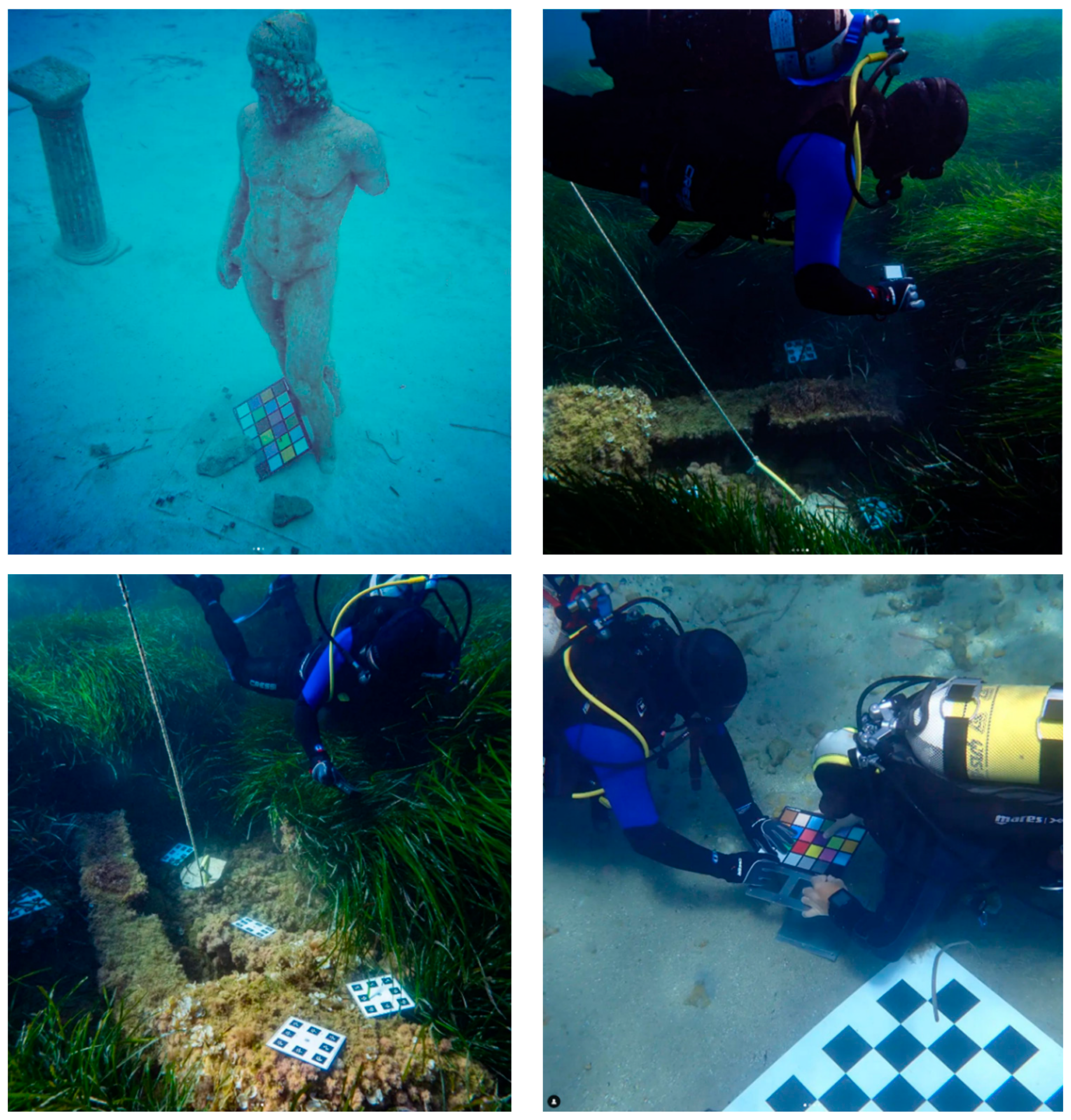
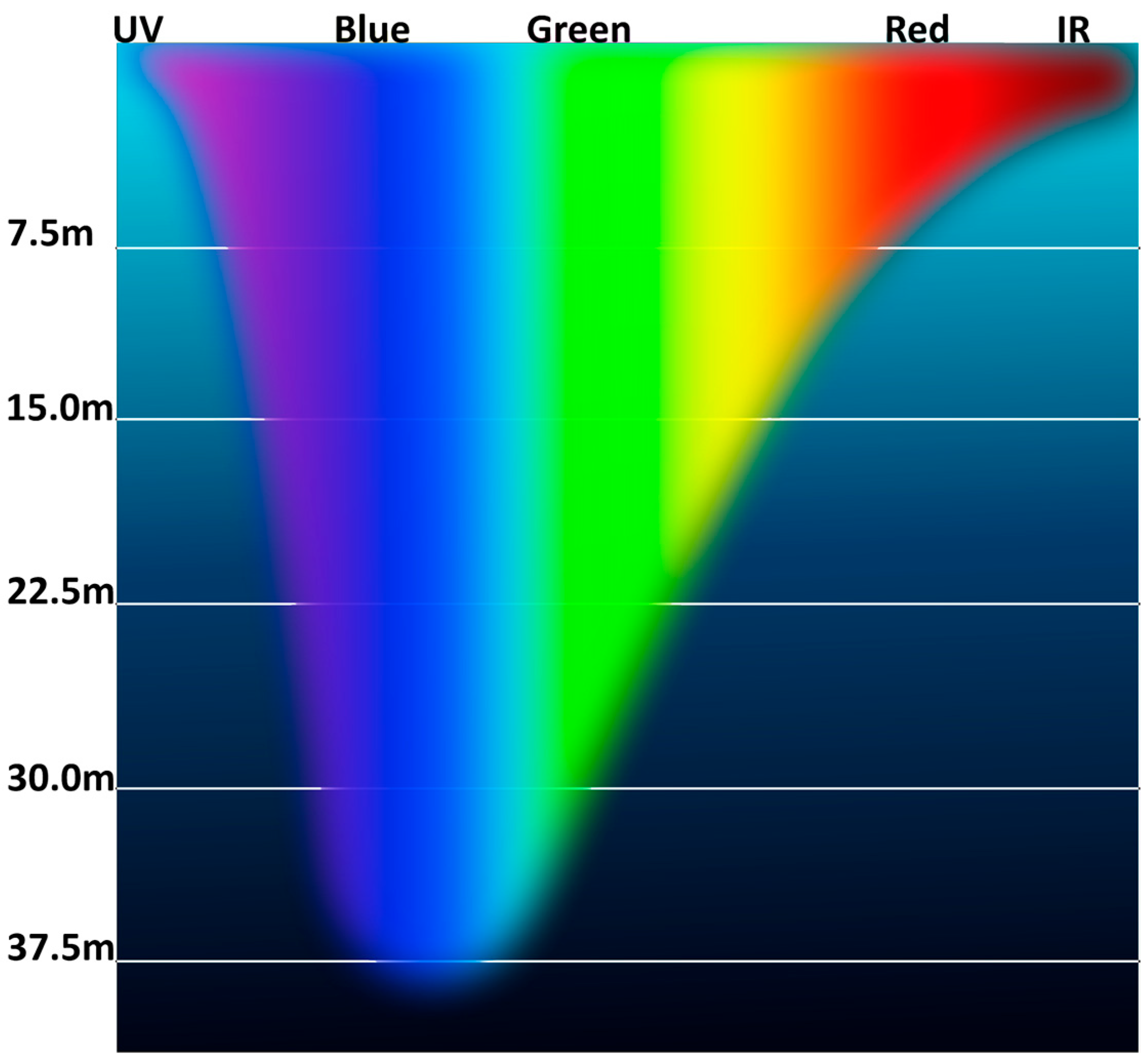

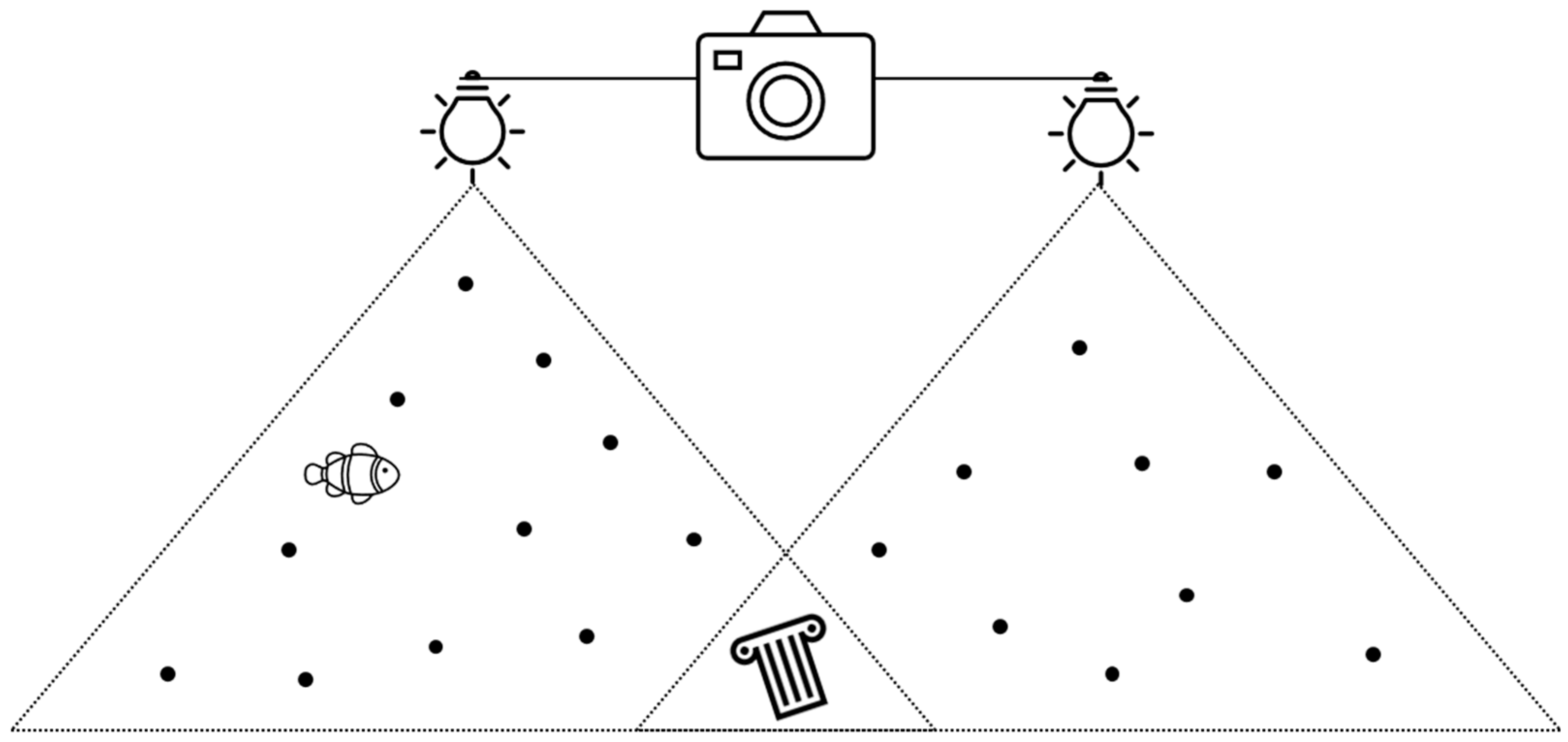
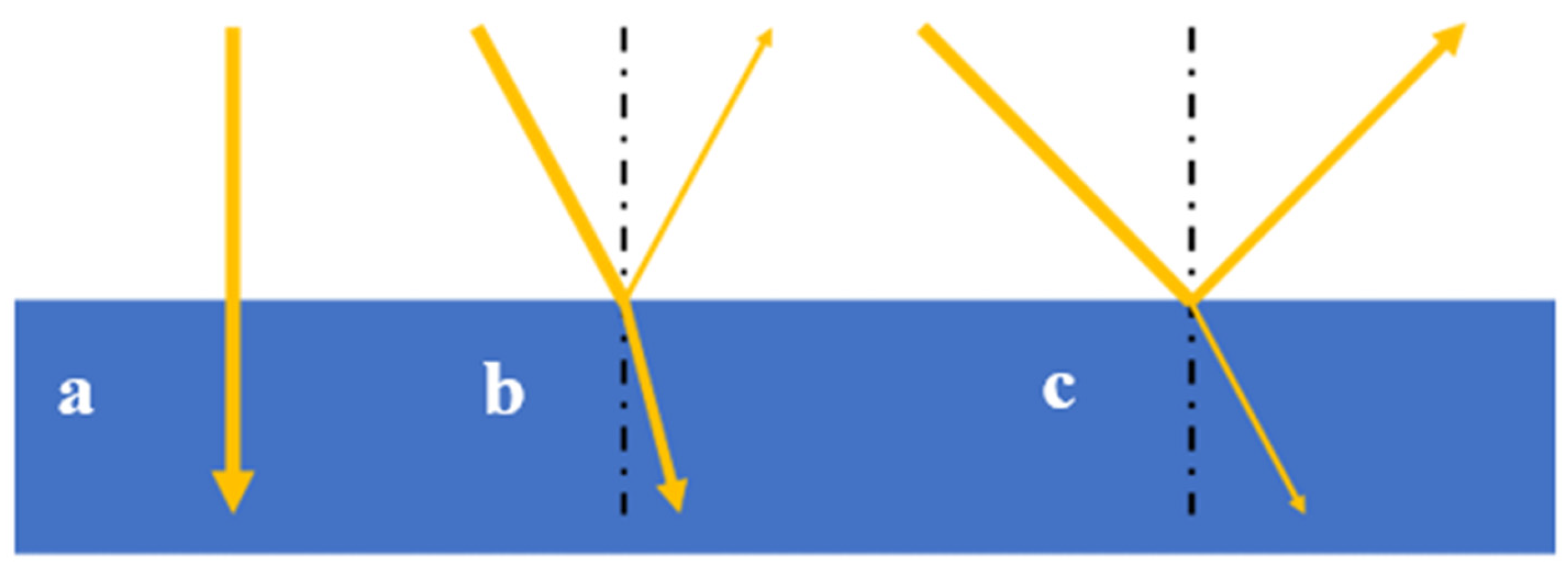
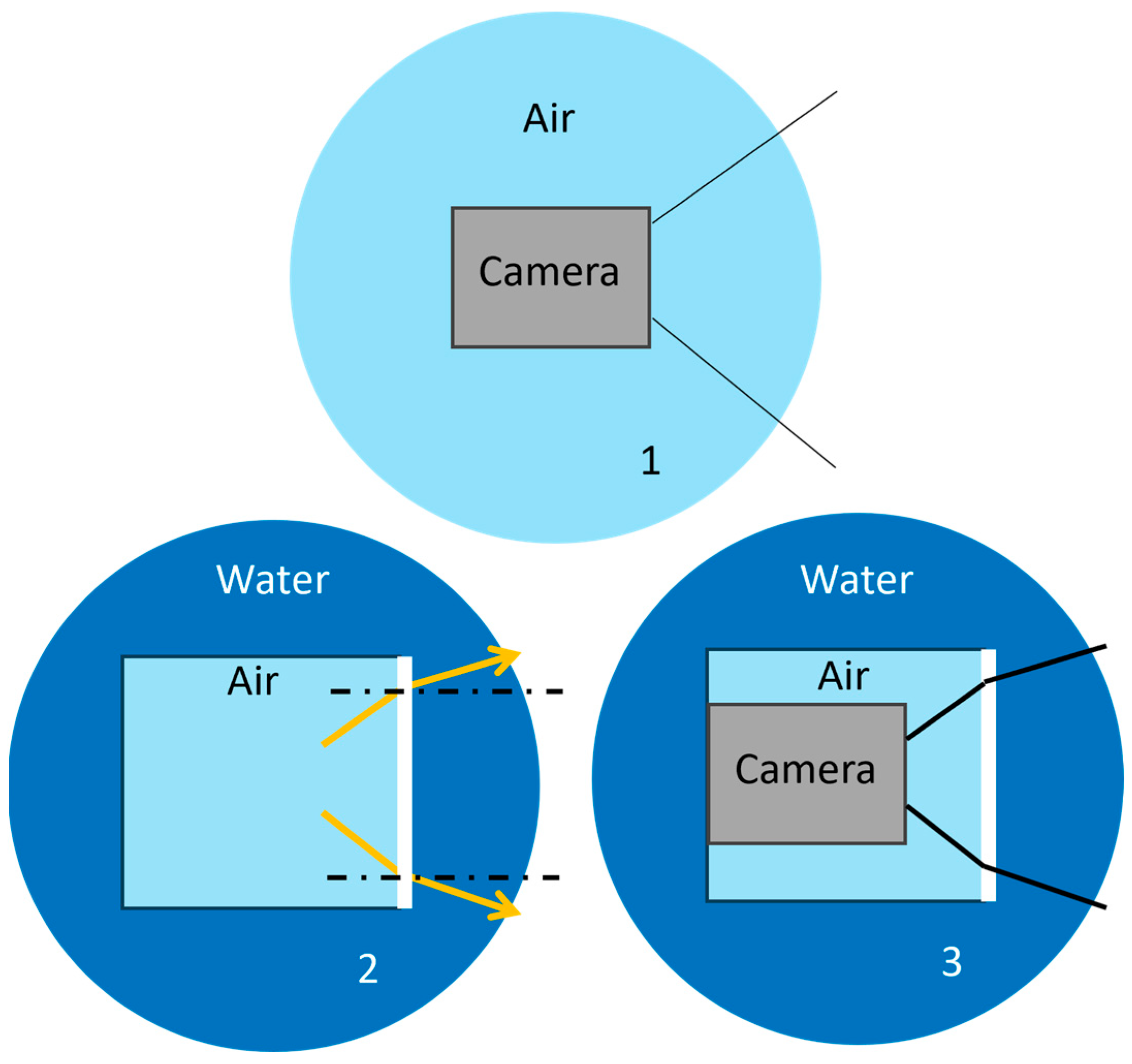
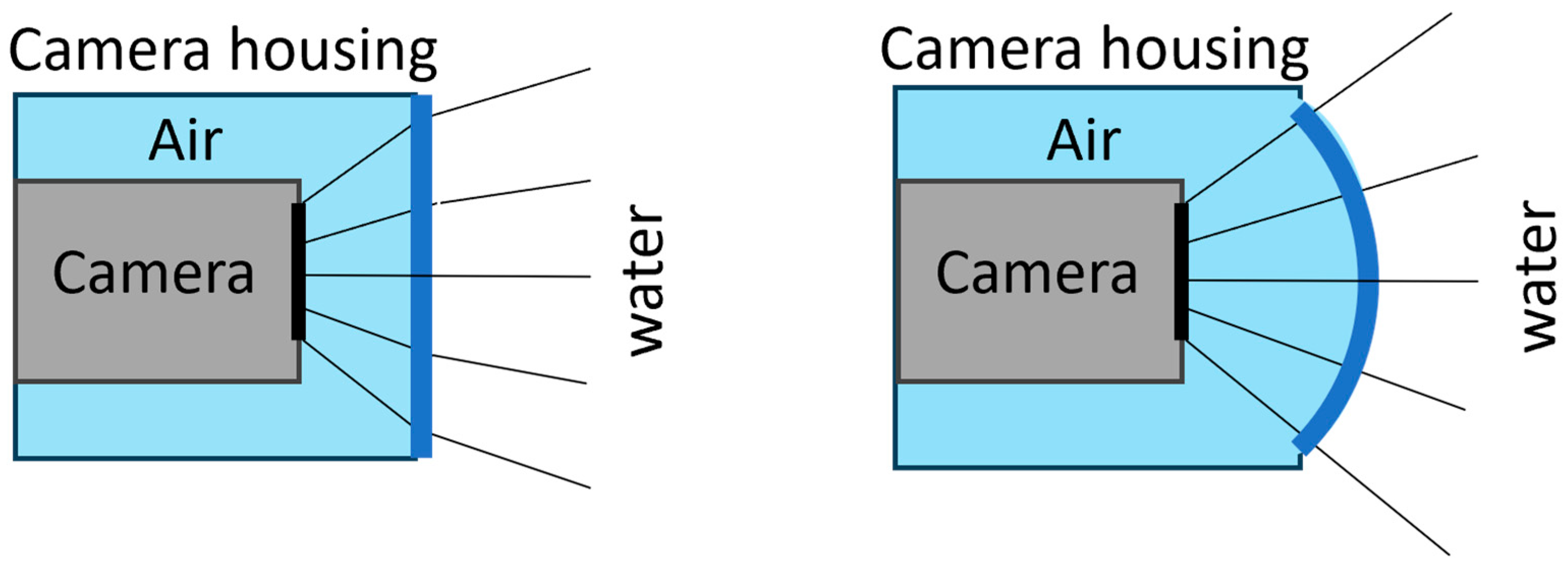




Disclaimer/Publisher’s Note: The statements, opinions and data contained in all publications are solely those of the individual author(s) and contributor(s) and not of MDPI and/or the editor(s). MDPI and/or the editor(s) disclaim responsibility for any injury to people or property resulting from any ideas, methods, instructions or products referred to in the content. |
© 2024 by the authors. Licensee MDPI, Basel, Switzerland. This article is an open access article distributed under the terms and conditions of the Creative Commons Attribution (CC BY) license (https://creativecommons.org/licenses/by/4.0/).
Share and Cite
Calantropio, A.; Chiabrando, F. Underwater Cultural Heritage Documentation Using Photogrammetry. J. Mar. Sci. Eng. 2024, 12, 413. https://doi.org/10.3390/jmse12030413
Calantropio A, Chiabrando F. Underwater Cultural Heritage Documentation Using Photogrammetry. Journal of Marine Science and Engineering. 2024; 12(3):413. https://doi.org/10.3390/jmse12030413
Chicago/Turabian StyleCalantropio, Alessio, and Filiberto Chiabrando. 2024. "Underwater Cultural Heritage Documentation Using Photogrammetry" Journal of Marine Science and Engineering 12, no. 3: 413. https://doi.org/10.3390/jmse12030413




